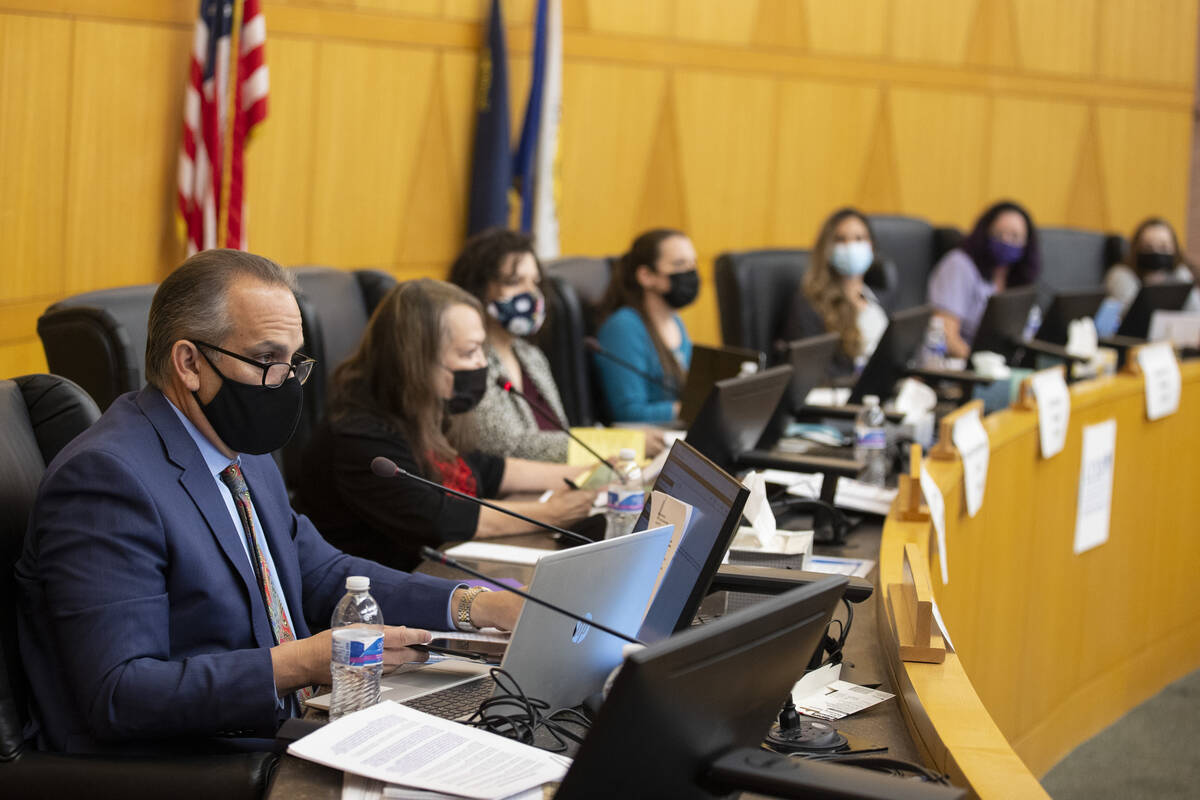CCSD looks to change zone variance rules to reduce school shopping
The Clark County School District is considering changes to a policy that could mean parents won’t be able to enroll their child at a school outside their assigned attendance zone if that campus is already at or above capacity.
The School Board heard a presentation on Aug. 26 and approved notices of intent. Trustees will consider granting final approval on Sept. 23.
District officials say they want to change the zone variance process so it’s similar to one used for magnet school applications. It would create a centralized application process — instead of having school principals approve requests — and space would have to be available at a school in order for a variance to be considered.
“We really want to ensure that as this operationalizes, it mirrors the magnet school process as closely as it can,” Mike Barton, chief college, career, equity and school choice officer, told the board.
District officials said there’s currently no central system for tracking detailed data, including monitoring who has applied for a variance and the ethnicity of those students.
The recommendations are centered around two concepts — equity and efficiency, Barton said, adding that previously “schools with the highest numbers of zone variances had the highest number of Caucasian students attending.”
The district faced a recent lawsuit about zone variances, said Gia Moore, director of college and career readiness and school choice, noting there have been concerns about transparency and consistency in terms of how variances are approved or denied.
The school district, which has more than 308,000 students, currently has granted 19,011 zone variances.
Of the district’s more than 360 schools, 122 campuses have 50 or more zone variances and 181 are over 100 percent capacity, according to a district presentation.
Process criticized by equity panel
The proposed changes came after a district equity commission report that “highlighted practices that were not contributing positively towards equity and access efforts,” according to online school board meeting materials. A working group of principals also was formed to brainstorm proposed changes.
Amy Kaplan, who moved with her son, Kevin, to Las Vegas at the end of last school year from Orange County, California, had a different complaint about the current system.
She said that after her son finished last year online, they were surprised to learn that he was zoned to attend Bonanza High School, which is about 8 miles from their home, rather than Palo Verde High School, which is only about 2 miles away.
Kaplan said she looked into the schools and their academic performance and was concerned about what she believes are crime and violence issues at Bonanza.
She applied for a zone variance for her son seeking to allow him to attend Palo Verde, but it was denied.
Kaplan said the process was confusing and lacked transparency. The reason she was given for the denial was her son’s grades weren’t good enough, she said, though she told the principal that wasn’t fair since a lot of students, her son included, struggled with grades during distance education.
She said the principal told her that if her son could get his grades up, he’d reconsider. His grades did improve, she said, but he was still denied.
Now, her son is a sophomore at Bonanza High and has made friends, so Kaplan said she doesn’t intend to go through the zone variance process again. But she is still upset about how her request was handled. She had not heard about proposed changes to the school district’s policy.
What would change
The current process requires parents to fill out an application seeking a zone variance for their child and submit it to the principal of the school they would prefer he or she attend. That principal then consults with the principal of the school the child had been attending before deciding whether to approve or reject the request.
Principals are instructed to consider factors such as enrollment for the upcoming school year and “racial and ethnic diversity,” according to meeting materials.
If a zone variance is approved, it is effective for one year and can be extended.
Under the new system, the application process for zone variances would be handled centrally by the school district administrative office instead of by individual schools.
Parents would submit an online application. A lottery would be conducted if there are more applicants than available seats “just like we do with the magnet process,” Moore said.
If a student is selected, they’d be required to stay at the school for at least a year.
Parents would apply from November through January for the following school year, and would be notified in February or March of the outcome.
If seats remain available, the application process would continue until the 10th day of the new school year.
Transportation wouldn’t be offered for students attending a school under a zone variance. And under Nevada Interscholastic Activities Association rules, students can’t play varsity sports for a year if they change schools under a variance.
Students would be automatically approved if they fall into certain categories, including being assigned to a school under their Individualized Education Program (IEP), having made an English language learner election, are assigned to a Prime 6 school option or are homeless or in foster care.
Kids can follow employee parents
The School Board received a couple dozen written public comments at a June meeting to discuss the proposal, the vast majority of which were from teachers who were concerned they wouldn’t be able to have their children attend the school where they work.
Trustee Danielle Ford indicated at the Aug. 26 meeting that staff had rewritten that provision to allow district employees to take their children with them to the school where they’re employed.
If employees hadn’t been allowed to do that, “that would be terrible,” Ford said.
High school teacher Sarah Comroe told the School Board she hopes the changes to the policy related to employees and their children is accurate.
“If so, I definitely appreciate it and thank you for listening,” she said.
Comroe said the district’s presentation includes information about the cost of placing portable classrooms on school campuses, but noted some schools have portables for reasons that have little or nothing to do with zone variances.
At Rancho High School, where she works, there are more than 25 portables because just like most schools in the district, it’s overcrowded and overcapacity in general, she said.
Comroe said she thinks the district needs to build more schools, noting she knows that’s ongoing, and additional buildings are needed at existing schools.
Trustee Katie Williams expressed concern at the August meeting about online meeting reference material stating that the district will monitor the diversity of students requesting a change of school assignment. She said her concern is that students won’t be able to attend a school based on their skin color.
Superintendent Jesus Jara assured her that’s not going to be an issue.
Ford said she likes that the district is trying to emulate the magnet school admissions process.
She asked if there will be anything with the zone variance policy that will be weighted in consideration of younger siblings to allow them to attend the same school as older siblings.
Barton said it will be an operational discussion, and the district will have to look at data and capacity information it doesn’t have yet. But, he said, the intent is to mirror the magnet school process as closely as possible.
Trustee Evelyn Garcia Morales noted that families sometimes have a difficult time navigating the magnet school application system and said she’s glad school district outreach efforts to connect with families will continue.
“It is an essential aspect of this,” she said.
Contact Julie Wootton-Greener at jgreener@reviewjournal.com or 702-387-2921. Follow @julieswootton on Twitter.


















